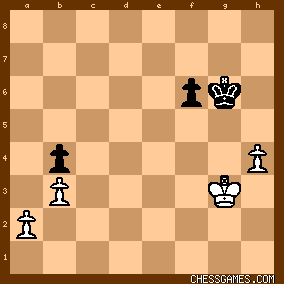| Aug-14-12 | | DrGridlock: This game makes an appearance in Reuben Fine's "Basic Chess Endings" (diagram #55). The position would have been the result if black had played 40 ... Bxg3, 41 Kxg3. 
click for larger viewFine claims, "[the diagram is], a position which could have occurred in the game Kmoch-Van Schletinga, Amsterdam, 1936. White to play would win at once by 1 K-B4. But Black to play can draw by 1 ... K-B4!; 2 K-B3, K-K4!!. If now 3 P-R5, K-B4 and the pawn is lost, while if 3 K-Kt4, K-K5!; 4 P-R5, P-B4ch; 5 K-Kt3, K-K6; 6 P-R6, P-B5ch and both pawns queen simultaneously." Fine's implication is that Black could draw by playing 40 ... Bxg3, while the game continuation 40 ... Bc3 lead to black's loss. Botvinnik also quotes this position in "One Hundred Selected Games." Botvinnik writes, "I was haunted by the thought that I had seen a similar position already somewhere. Reuben Fine's book, Basic Chess Endings, came to my aid. The diagram opposite is of an ending which could have arisen in a Kmoch-Van Schletinga game, at Amsterdam in 1936, and it closely recalls the one that arose in my game. Analysing this position, Fine that pointed out that with Black to move, after 1 ... K-B4!; ... the game whould end in a draw." Fine's analysis, however, is wrong.
If instead after f5 +:

click for larger viewWhite plays K-h3 instead of K-g3 (in Fine's line), the game is won for White. |
Dec-14-13
 | | wwall: 40...Bxg3 41.Kxg3 Kf5 42.Kf3 Ke5, now 43.a4! wins easy enough. After 43.a4 Kd5 44.h5 and the rook pawn will queen. Instead of 43.a4, 43.Kg4 Ke4 44.h5 f5+ 45.Kg3 still wins for White (though 45.Kh3 is stronger and wins faster, with the threat of h6 or a4). After 45.Kg3 Ke3 46.h6 f4+ 47.Kg4 f3 48.h7 f2 49.h8=Q f1=Q 50.Qh3+ trades off queens and wins. |





































